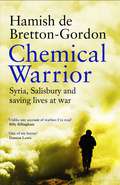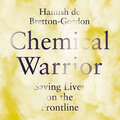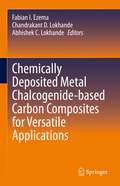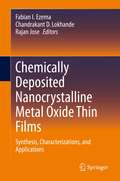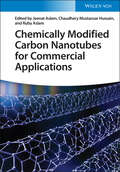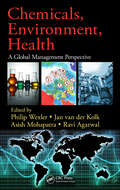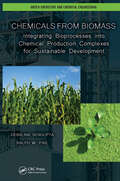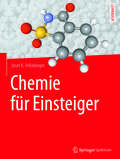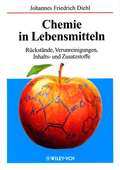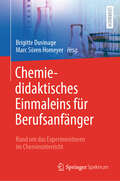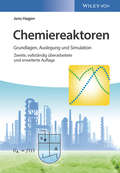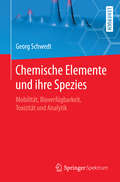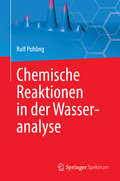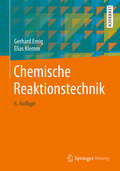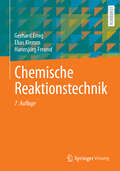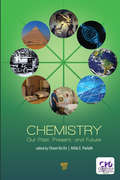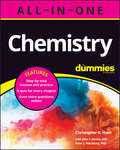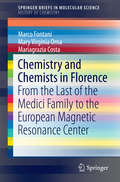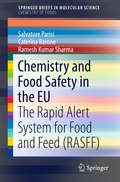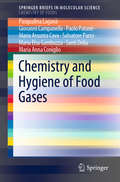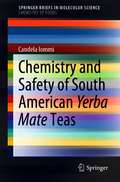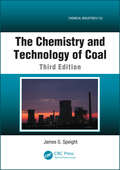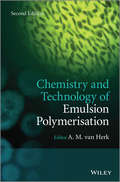- Table View
- List View
Chemical Warrior: Syria, Salisbury and Saving Lives at War
by Hamish de Bretton-GordonGRIPPING, MOVING AND INSPIRING: the remarkable life of a world-leading expert in chemical weapons defence."Unlike any account of warfare I've read" - Billy BillinghamFor thirty years, Hamish has served and volunteered in conflict zones around the world. As the army's foremost chemical weapons expert, he built a unique first-hand understanding of how to prevent attacks and train doctors on the frontline - saving countless lives in the process.After suffering near-death experiences time and again, Hamish discovered he had a ticking time bomb in his own chest: a heart condition called Sudden Death Syndrome that could kill him at any time. But with a new awareness for the fragility of life, he fought harder to make his count.Despite facing extraordinary personal danger, Hamish has unearthed evidence of multiple chemical attacks in Syria and continues to advise the government at the highest level, including after the 2018 Novichok poisoning in Salisbury. Lifting the lid on Hamish's unique world of battlefield expertise and humanitarian work, Chemical Warrior is a thrilling story of bravery and compassion.
Chemical Warrior: Syria, Salisbury and Saving Lives at War
by Hamish de Bretton-GordonGRIPPING, MOVING AND INSPIRING: the remarkable life of a world-leading expert in chemical weapons defence. "His work has saved lives and given hope." - Professor David Nott, bestselling author of War Doctor For thirty years, Hamish has served and volunteered in conflict zones around the world. As the army's foremost chemical weapons expert, he built a unique first-hand understanding of how to prevent attacks and train doctors on the frontline - saving countless lives in the process. After suffering near-death experiences time and again, Hamish discovered he had a ticking time bomb in his own chest: a heart condition called Sudden Death Syndrome that could kill him at any time. But with a new awareness for the fragility of life, he fought harder to make his count. Despite facing extraordinary personal danger, Hamish has unearthed evidence of multiple chemical attacks in Syria and continues to advise the government at the highest level, including after the 2018 Novichok poisoning in Salisbury. Lifting the lid on Hamish's unique world of battlefield expertise and humanitarian work, Chemical Warrior is a thrilling story of bravery and compassion.(P)2020 Headline Publishing Group Limited
Chemically Deposited Metal Chalcogenide-based Carbon Composites for Versatile Applications
by Fabian I. Ezema Chandrakant D. Lokhande Abhishek C. LokhandeThis book satisfies the interest and curiosity of beginners in thin film electrode preparations, characterizations, and device making, while providing insight into the area for experts. The considerable literature on ‘metal chalcogenides based carbon composites and their versatile applications’ reflect its importance for research and demonstrate how it’s now reached a level where the timely review is necessary to understand the current progress and recent trends and future opportunities. In the book, the authors examine recent advances in the state-of-the-art fabrication techniques of metal sulfide based carbon composites along with their working mechanisms, associated issues/solutions, and possible future are discussed. In addition, detailed insight into the properties and various applications including principles, design, fabrication, and engineering aspects are further discussed.
Chemically Deposited Nanocrystalline Metal Oxide Thin Films: Synthesis, Characterizations, and Applications
by Fabian I. Ezema Chandrakant D. Lokhande Rajan JoseThis book guides beginners in the areas of thin film preparation, characterization, and device making, while providing insight into these areas for experts. As chemically deposited metal oxides are currently gaining attention in development of devices such as solar cells, supercapacitors, batteries, sensors, etc., the book illustrates how the chemical deposition route is emerging as a relatively inexpensive, simple, and convenient solution for large area deposition. The advancement in the nanostructured materials for the development of devices is fully discussed.
Chemically Modified Carbon Nanotubes for Commercial Applications
by Chaudhery Mustansar Hussain Jeenat Aslam Ruby AslamChemically Modified Carbon Nanotubes for Commercial Applications Discover the go-to handbook for developers and application-oriented researchers who use carbon nanotubes in real products Carbon nanotubes have held much interest for researchers since their discovery in 1991. Due to their low mass density, large aspect ratio, and unique physical, chemical, and electronic properties, they provide a fertile ground for innovation in nanoscale applications. The development of chemical modifications that can enhance the poor dispersion of carbon nanotubes in solvents and improve interactions with other materials have enabled extensive industrial applications in a variety of fields. As the chemistry of carbon nanotubes and their functionalization becomes better understood, Chemically Modified Carbon Nanotubes for Commercial Applications presents the most recent developments of chemically modified carbon nanotubes and emphasizes the broad appeal for commercial purposes along many avenues of interest. The book reviews their already realized and prospective applications in fields such as electronics, photonics, separation science, food packaging, environmental monitoring and protecting, sensing technology, and biomedicine. By focusing on their commercialization prospects, this resource offers a unique approach to a significant and cutting-edge discipline. In Chemically Modified Carbon Nanotubes for Commercial Applications readers will also find: Case studies that emphasize the information presented in each chapter Each chapter includes important websites and suggested reading materials Discussion of current applications of the relevant methodologies in every chapter A look at future perspectives in each application area to highlight the scope for next steps within the industry Chemically Modified Carbon Nanotubes for Commercial Applications is a valuable reference for material scientists, chemists (especially those focused on environmental concerns), and chemical and materials engineering scientists working in R&D and academia who want to learn more about chemically modified carbon nanotubes for various scalable commercial applications. It is also a useful resource for a broad audience: anyone interested in the fields of nanomaterials, nanoadsorbents, nanomedicine, bioinspired nanomaterials, nanotechnology, nanodevices, nanocomposites, biomedical application of nanomaterials, nano-engineering, and high energy applications.
Chemicals, Environment, Health: A Global Management Perspective
by Philip Wexler Jan van der Kolk Asish Mohapatra Ravi AgarwalThe past 40 years have seen a phenomenal growth in globally oriented public and private initiatives related to chemical and environmental issues. The groundbreaking 1972 United Nations Conference on the Human Environment held in Stockholm was the event responsible for initiating framework for global environmental policies, including those addressin
Chemicals from Biomass: Integrating Bioprocesses into Chemical Production Complexes for Sustainable Development (Green Chemistry and Chemical Engineering)
by Debalina Sengupta Ralph W. PikeChemicals from Biomass: Integrating Bioprocesses into Chemical Production Complexes for Sustainable Development helps engineers optimize the development of new chemical and polymer plants that use renewable resources to replace the output of goods and services from existing plants. It also discusses the conversion of those existing plants into faci
Chemicals in the Food Industry: Toxicological Concerns and Safe Use (SpringerBriefs in Molecular Science)
by Michele Barone Rachid ChaibThis book addresses the use and management of chemicals in the food and beverage industry. The authors explore the use of chemicals as food additives and sanitizers, and provide an overview of their toxicological characterisation with regard to the employees who handle them, and to consumers. In addition, the authors pay special attention to the safe and reliable management of chemicals in the food production and packaging areas, and in quality control laboratories. Topics such as toxicological risks, the importance of labelling, technical and material safety data sheets, risk categories (e.g. fire, explosion, unforeseen chemical reactions, etc.), safe use of hazardous chemicals, prevention procedures, and emergency planning in laboratories and industrial areas are also covered. In closing, readers will learn more about the future behaviour of food-production workers regarding chemical handling and approved uses, especially in light of the recent REACH obligations.Given its scope, the book will appeal not only to researchers interested in food production, food safety, risk prevention and public health, but also to professionals involved in quality control and risk assessment in the food and beverage industry.
Chemie für Einsteiger
by Josef K. FelixbergerDas Buch ist eine leicht verständliche Einführung in die Welt der Chemie mit hohem praktischem Nutzen, angereichert mit zahlreichen anschaulichen Beispielen aus Alltag, Industrie, Wirtschaft, Politik und Geschichte. Eine reich bebilderte Darstellung der Allgemeinen und Anorganischen Chemie, der Organischen Chemie und Biochemie und last, but not least der Polymerchemie und Kunststoffverarbeitung. Gleichermaßen empfehlenswert für Studienanfänger mit Nebenfach Chemie, für Kaufleute und Techniker, Schüler und Lehrer sowie für interessierte Laien.
Chemie in Lebensmitteln: Rückstände, Verunreinigungen, Inhalts- und Zusatzstoffe (Universitätstaschenbücher Ser. #675)
by Johannes Friedrich DiehlFast taglich berichten die Medien Ãber Lebensmittelskandale und "chemisch verseuchte" Nahrung. Ob Rackstände von Pflanzenschutzmitteln in Obst und Gemase, von Tierarzneimitteln in Fleisch, Milch und Eiern, ob Schwermetalle oder Dioxine - mit modernen Analysenverfahren kannen die geringsten Spuren solcher Stoffe sehr zuverlassig nachgewiesen werden. Aber welche gesundheitliche Risiken sind mit dem Vorhandensein dieser Substanzen in der Nahrung verbunden? Die Lebensmittelbranche versichert uns, ihre Produkte seien nicht nur unbedenklich zu genieà en, sondern gesundheitlich sicherer als je zuvor. Kritiker des heutigen Lebensmittelangebots warnen dagegen vor schlimmen Folgen. Was stimmt nun, welche Argumente kannen Ãberzeugen? Ein solch komplexes und heikles Thema wie "Chemie in Lebensmitteln" verlangt nach Beurteilung und Erlauterung durch unabhangige Experten. Als solcher hat sich Johannes Friedrich Diehl, viele Jahre Leiter der Bundesforschungsanstalt far Ernährung, durch zahlreiche Veraffentlichungen und Gutachten sowie durch seine Mitarbeit in Beratergremien einen Namen gemacht. Ohne zu beschanigen und ohne zu dramatisieren berichtet er Ãber die neuesten Erkenntnisse zur gesundheitlichen Qualitat von Lebensmitteln, Ãber aktuelle Entwicklungen bei der Zulassung und Verwendung von Zusatzstoffen, Ãber den erstaunlichen Wandel in den Ansichten Ãber Zusammenhänge zwischen Ernährung und Krebs, Allergien und anderen Krankheiten sowie Ãber die gesundheitsschädlichen und -fardernden Wirkungen natürlicher Lebensmittelinhaltsstoffe. Das mit fundiertem wissenschaftlichem Hintergrund, jedoch far einen breiten Leserkreis geschriebene Buch kann zugleich als fesselnde Lektare und als Nachschlagewerk Ernahrungsberatern, à rzten, Apothekern, Ökotrophologen, Agronomen und Chemikern dienen - natarlich auch allen, die sich eine eigene Meinung bilden wollen.
Chemiedidaktisches Einmaleins für Berufsanfänger: Rund um das Experimentieren im Chemieunterricht
by Brigitte Duvinage Marc Sören HomeyerDieses Lehrbuch richtet sich insbesondere an Quereinsteiger für das Fach Chemie, um Ihnen für den Berufseinstieg wesentliche fachdidaktische Grundlagenkenntnisse, die in steter Wechselbeziehung mit dem Einsatz von Experimenten und dem Aufbau von Wissensstrukturen stehen, aufzuzeigen. Die damit verbundenen Kompetenzentwicklungen werden praxisrelevant in den Kapiteln diskutiert, und sie sind mühelos autodidaktisch zu erschließen. In ausgewählten Unterrichtsbausteinen werden theoretisch diskutierte Aspekte mit Blick auf den Beitrag des Experimentes und der Entwicklung rahmenplanadäquater Kompetenzen konkretisiert. Unterschiedliche Materialien für die Planung und den Unterricht sind darin eingebunden. Didaktisch-methodische Hinweise runden die Kapitel ab. Im Kapitel 14 steht das sichere und souveräne Experimentieren mit und für Lernende im Mittelpunkt. Aufgaben und Lösungen in einzelnen Kapiteln dienen der Überprüfung der eigenen Kompetenzen für die Planungsarbeit. Letztlich werden auch Referendare und Lehrende für Naturwissenschaften in diesem Buch einen nicht zu unterschätzenden Wissensfundus entdecken.
Chemiereaktoren: Grundlagen, Auslegung und Simulation
by Jens HagenKenntnisse der Auslegung und Simulation von Chemiereaktoren sind die Voraussetzung für den optimalen technischen und wirtschaftlichen Betrieb von chemischen Prozessen. In der neuen Auflage von "Chemiereaktoren" gibt Jens Hagen einen bewährten und verständlichen Einstieg in das komplexe Thema und vermittelt die Grundlagen der Reaktionstechnik. Alle erforderlichen Auslegungsgleichungen auf Basis der Stoff-, Wärme- und Impulsbilanz unter Berücksichtigung von Stöchiometrie und Kinetik der Reaktionen werden abgeleitet und erläutert. Jedes Kapitel enthält vollständig durchgerechnete Beispiele und Übungsaufgaben mit kommentierten Lösungen. Um einen Einstieg in die Modellierung und Simulation von Chemiereaktoren zu geben, nutzt Jens Hagen das Softwarepaket POLYMATH, das das Finden von numerischen Problemlösungen leicht nachvollziehbar und mit geringem Aufwand erlaubt. Zielgerichtet wird die Modellierung von Problemstellungen geübt und es werden verständliche Lösungswege aufgezeigt, um Probleme aus der Praxis zu lösen. In der zweiten Auflage wurde das Buch um die Lösung von Differenzialgleichungen zweiter Ordnung und von partiellen Differenzialgleichungen erweitert, um komplexere Fragestellungen des Stoff- und Wärmeaustauschs lösen zu können. Zusätzlich wurden viele neue Beispiele und Simulationen aufgenommen, die reale Probleme in der Reaktionstechnik widerspiegeln und eine Übertragung der Beispiele in die Praxis erleichtern.
Chemische Elemente und ihre Spezies: Mobilität, Bioverfügbarkeit, Toxizität und Analytik
by Georg SchwedtDas Buch stellt Methoden und Strategien zur differenzierten Analytik und Bewertung von chemischen Elementen in Wasser, Boden und Lebensmitteln vor zum Zwecke der Bewertung von Mobilit#65533;t, Toxizit#65533;t und Bioverf#65533;gbarkeit. Denn es ist eben nicht nur die Dosis, die ein Gift zum Gift macht, sondern auch die Art der Spezies.
Chemische Reaktionen in der Wasseranalyse
by Rolf PohlingDieses Buch ist dem Praktiker eine Hilfe in der Wasseranalyse. Es erläutert die chemischen Reaktionen und Zusammenhänge, z. B. warum sich eine Lösung durch Zugabe eines spezifischen Reagenzes färbt, es werden aber auch die Reaktionen zur Beseitigung von Störungen aufgezeigt. Es können in der Analyse auch mehrere Störungen auftreten. Damit verfügt der Wasseranalytiker über eine Ergänzung zu seinem analytischem Vorschriftenbuch. Insgesamt kann dabei ein beträchtliches theoretisches Rüstzeug erarbeitet werden, das nicht nur für die Wasseranalyse von Bedeutung ist. Es sind 40 Parameter in alphabetischer Reihenfolge aufgezeigt, in denen bis zu 10 Methoden des Parameters als chemische Reaktionen und mit ihren organischen Strukturen aufgeführt sind. Zusätzlich sind Vorkommen, Herkunft und Bedeutung der Verschmutzungsparameter beschrieben. Das Buch trägt damit erheblich zum Verständnis der Wasseranalyse bei und darf in keinem Labor fehlen, in dem Wasseranalysen durchgeführt werden.
Chemische Reaktionstechnik: Einfuhrung In Die Chemische Reaktionstechnik (Springer-Lehrbuch)
by Gerhard Emig Elias KlemmDie neue vollständig überarbeitete Auflage dieses schon klassischen Lehrbuches berücksichtigt vor allem den Einsatz moderner Methoden in der chemischen Reaktionstechnik sowie die Entwicklungstendenzen im Bereich Modellierung und damit in der Computeranwendung. Dies ist auch der Grund, weshalb ein weiterer Autor aus dem aktiven Hochschuldienst das Autorenteam ergänzt. Im einzelnen wurden folgende Teile neu aufgenommen: - Fluid-Fluid-Reaktionen - Stöchiometrie chemischer Reaktionen - Wirbelschichtreaktoren - Stark erweiterter mathematischer Anhang, zugeschnitten auf den Computereinsatz - Symbolverzeichnis
Chemische Reaktionstechnik
by Gerhard Emig Elias Klemm Hannsjörg FreundDieses Werk ist ein bewährter Lehrbuch-Klassiker im Bereich der Technischen Chemie. Als vollständige Einführung in das Fachgebiet der Chemischen Reaktionstechnik unterstützt es in idealer Weise sowohl das akademische Studium als auch die Arbeit in der industriellen Praxis. Es ist für die Fachrichtungen Chemieingenieurwesen, Chemie und Verfahrenstechnik gleichermaßen geeignet und wird seit vielen Jahren im Lehrprofil Technische Chemie der DECHEMA empfohlen.Mit dieser Neuauflage erfolgte eine leichte Überarbeitung und die Ergänzung eines neuen Kapitels zur elektrochemischen Reaktionstechnik. Gliederung und Struktur des Lehrbuchs haben sich bewährt und wurden beibehalten.
Chemistry: Our Past, Present, and Future
by Attila E. PavlathThis book discusses the vital role of chemistry in everyday life. It encourages readers to understand how the knowledge of chemistry is important for the development of society and a better future. The text is organized into three parts. Part 1 covers the historical aspects of chemistry and discusses how countless discoveries since the beginning of life on earth have benefited human beings. Part 2 focuses on modern life and describes chemistry’s contribution to the developments in the fields of food and agriculture, energy, transportation, medicine, and communications. Part 3 emphasizes the role of chemists and educators in making the layperson aware of the benefits of chemistry without having them to go through its complexities. Written in an easy-to-understand manner and supplemented by ample number of figures and tables, the book will cater to a broad readership ranging from general readers to experts.
Chemistry All-in-One For Dummies (+ Chapter Quizzes Online)
by Christopher R. Hren John T. Moore Peter J. MikuleckyEverything you need to crush chemistry with confidence Chemistry All-in-One For Dummies arms you with all the no-nonsense, how-to content you&’ll need to pass your chemistry class with flying colors. You&’ll find tons of practical examples and practice problems, and you&’ll get access to an online quiz for every chapter. Reinforce the concepts you learn in the classroom and beef up your understanding of all the chemistry topics covered in the standard curriculum. Prepping for the AP Chemistry exam? Dummies has your back, with plenty of review before test day. With clear definitions, concise explanations, and plenty of helpful information on everything from matter and molecules to moles and measurements, Chemistry All-in-One For Dummies is a one-stop resource for chem students of all valences. Review all the topics covered in a full-year high school chemistry course or one semester of college chemistry Understand atoms, molecules, and the periodic table of elements Master chemical equations, solutions, and states of matter Complete practice problems and end-of-chapter quizzes (online!)Chemistry All-In-One For Dummies is perfect for students who need help with coursework or want to cram extra hard to ace that chem test.
Chemistry and Chemists in Florence: From the Last of the Medici Family to the European Magnetic Resonance Center (SpringerBriefs in Molecular Science)
by Marco Fontani Mary Virginia Orna Mariagrazia CostaThis brief offers a novel vision of the city of Florence, tracing the development of chemistry via the biographies of its most illustrious chemists. It documents not only important scientific research that came from the hands of Galileo Galilei and the physicists who followed in his footsteps, but also the growth of new disciplines such as chemistry, pharmaceutical chemistry, and biochemistry. It recounts how, in the Middle Ages, chemistry began as an applied science that served to bolster the Florentine economy, particularly in the textile dyeing industry. Later, important scientific collections founded by the ruling Medici family served as the basis of renowned museums that now house priceless artifacts and instruments. Also described in this text are the chemists such as Hugo Schiff, Angelo Angeli, and Luigi Rolla, who were active over the course of the following century and a quarter. The authors tell the story of the evolution of the Royal University of Florence, which ultimately became the University of Florence. Of interest to historians and chemists, this tale is told through the lives and work of the principal actors in the university's department of chemistry.
Chemistry and Food Safety in the EU: The Rapid Alert System for Food and Feed (RASFF) (SpringerBriefs in Molecular Science)
by Salvatore Parisi Caterina Barone Ramesh Kumar SharmaThis Brief provides a general description of the European Rapid Alert System for Food and Feed (RASFF). It describes the RASFF approach on the legal level and with reference to notification procedures, including also new tools, which were launched in 2014: iRASFF and the RASFF Consumer Portal. In an introduction, the present status of the RASFF, which had originally been introduced in 1979, is briefly reviewed. It is described as the main basis of modern food policy in Europe, enabling member countries to take rapid corrective actions on the one hand, and to perform statistically reliable analyses of food-related hazards on the other hand. One chapter contains a statistical evaluation of RASFF notifications in general, and specifically with regard to chemical contaminants, including also allergens. In another chapter, reasons for rejections of food and feed at the European borders are analyzed in selected case studies. The Brief provides an easy description for the chemical dangers and contaminants it is referring to, outlining the names, properties, uses and importance in the food and feed industry, toxicological effects, and contamination sources. The last chapter offers an outlook on the future of the RASFF and possible expectations.
Chemistry and Hygiene of Food Additives (SpringerBriefs in Molecular Science)
by Salvatore Parisi Pasqualina Laganà Emanuela Avventuroso Giovanni Romano Maria Eufemia Gioffré Paolo Patanè Umberto Moscato Santi DeliaThis brief addresses important aspects of food additives. Through four chapters, the authors describe the chemistry of food additives, the regulatory classification of additives on a large-scale, the risks involved in using chemicals for food preparation - including implications this has on food hygiene, and case-study examples taken from the dairy industry. More specifically, chapter one provides a list of the technological purposes of food additives defined for European use; chapter two explains the 'General Standards for Food Additives' (Codex Alimentarius Commission) which is a harmonised, workable and indisputable international standard; chapter three describes the use of selected food additives in the dairy sector, particularly with relation to the production of yoghurt products; and chapter four addresses the impact of additives on human health. This brief is of interest to researchers working in the area of food production and international regulation, both in academia and industry.
Chemistry and Hygiene of Food Gases (SpringerBriefs in Molecular Science)
by Salvatore Parisi Pasqualina Laganà Paolo Patanè Santi Delia Maria Anna Coniglio Giovanni Campanella Maria Assunta Cava Maria Elsa GambuzzaThis book focuses on the use of food gases in the food industry, their different applications and their role in food processing, packaging and transportation. Since these gases come into contact with food, they must comply with strict of labeling, purity and hygiene standards in order to ensure food safety.The book discusses various implications of food gases in the food chain, providing examples of how they can be used to limit food waste and losses. The first two chapters examine the classification and role of food gases in Europe, and the third chapter then explores the chemical and physical features of commonly used food gases in the food and food packing industries. The fourth chapter highlights the impact of food gases on human health due to their possible abuse and misuse. This book appeals to researchers and professionals working in food production and quality control.
Chemistry and Safety of South American Yerba Mate Teas (SpringerBriefs in Molecular Science)
by Candela IommiThis book explores the traditional use of Ilex paraguariensis, a plant that is widely distributed in South America. Thanks to its purported properties, it has been used for centuries in the form of teas with a variety of names, including: ‘yerba mate’ (Argentina), ‘chimarrão’ (Brazil), and others. Ilex paraguariensis and its teas (also referred to as ‘mate teas’) are well known because of their alleged pharmacological effects in numerous common conditions, including obesity, osteoporosis, constipation, arthritis, and hypertension. These effects are generally ascribed to yerba mate teas because the botanical species contains bioactive and stimulating substances like caffeine (originally dubbed ‘mateine’), various alkaloids, and several phenolic acids. Interestingly, the chemical profiles of these teas can fluctuate over time, creating serious production problems. As a result, it is difficult to reliably determine their safety and health effects on humans. In response to the global interest in these products, this book offers a reference guide to ‘yerba mate’/‘chimarrão’ teas. It analyzes their chemical profiles, discusses their bioactive features, and addresses their safety and health effects. In addition, since the cultural heritage of yerba mate has greatly contributed to its international success, the book also provides information on its historical legacy, regulatory aspects, and the global market.
The Chemistry and Technology of Coal (Chemical Industries)
by James G. SpeightThe demand for coal use (for electricity generation) and coal products, particularly liquid fuels and chemical feedstocks, is increasing throughout the world. Traditional markets such as North America and Europe are experiencing a steady increase in demand whereas emerging Asian markets, such as India and China, are witnessing a rapid surge in dema
Chemistry and Technology of Emulsion Polymerisation
by A. M. van HerkChemistry and Technology of Emulsion Polymerisation 2e provides a practical and intuitive explanation of emulsion polymerization, in combination with both conventional and controlled radical polymerization. For those working in industry, coupling theory with everyday practice can be difficult. By carefully explaining the principles of the reaction, based on well-designed experimental investigation, the book explains how the principles relate to practical application.The second edition of this book includes a new chapter on morphology of latex particles, a rapidly progressing area where modelling the thermodynamic and kinetic aspects of phase separation and morphology has developed into a mature and powerful tool to predict and control morphology of latex particles. Another area that is rapidly progressing is the application of controlled radical polymerisation in emulsion polymerization. Controlled radical polymerisation is used in aiding encapsulation of inorganic particles like pigment particles and clay platelets. These latest developments are included in the second edition.
